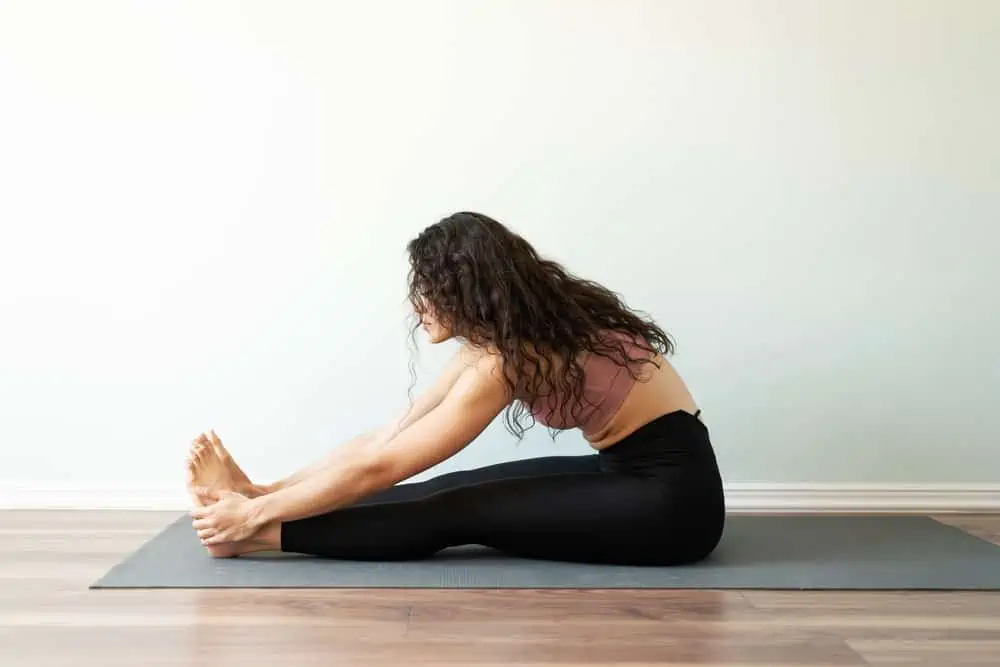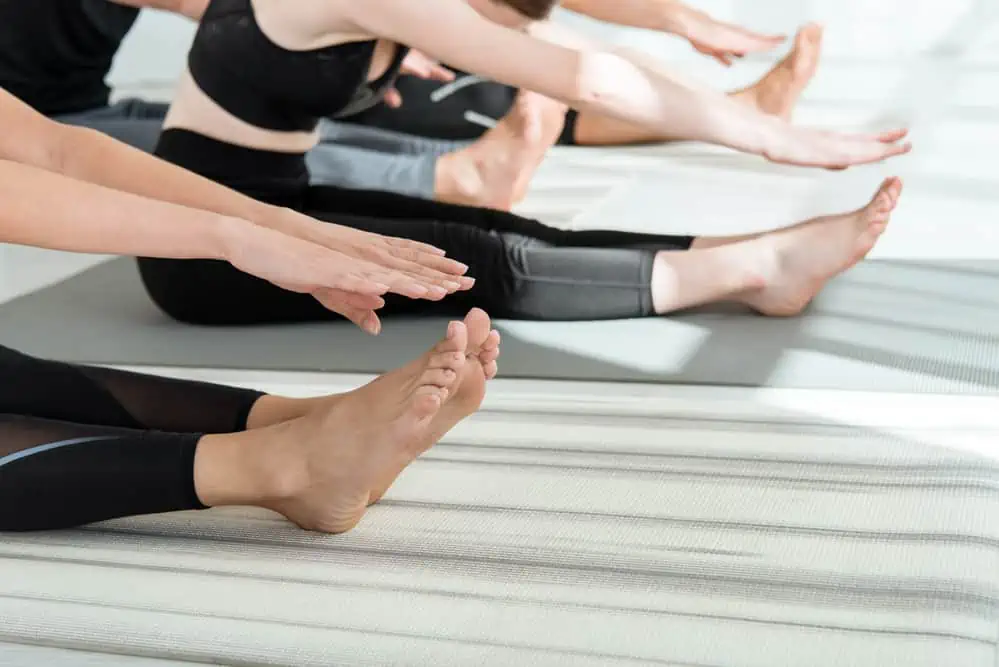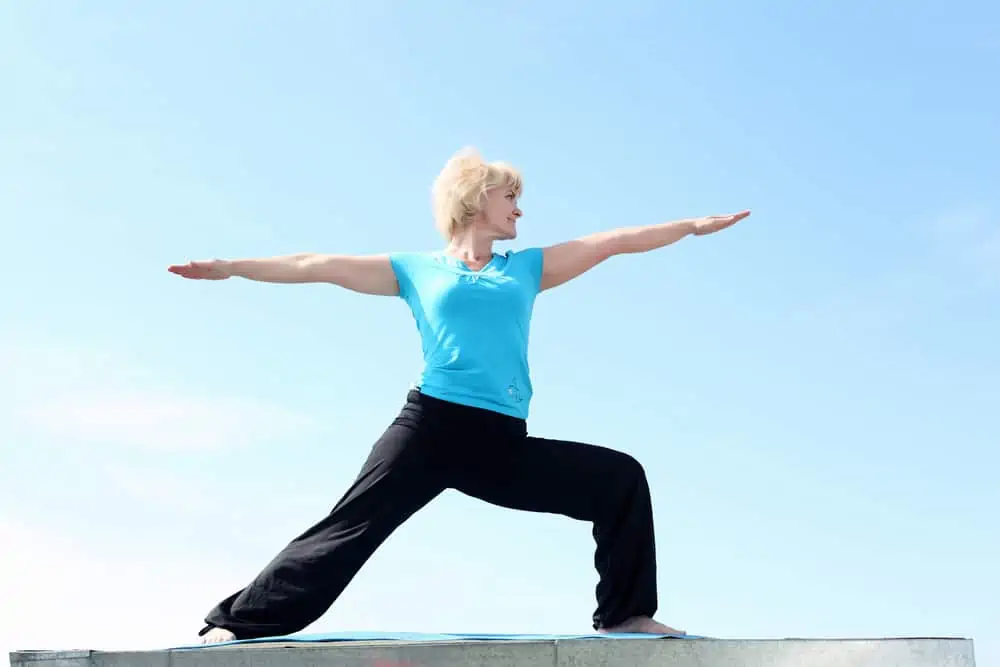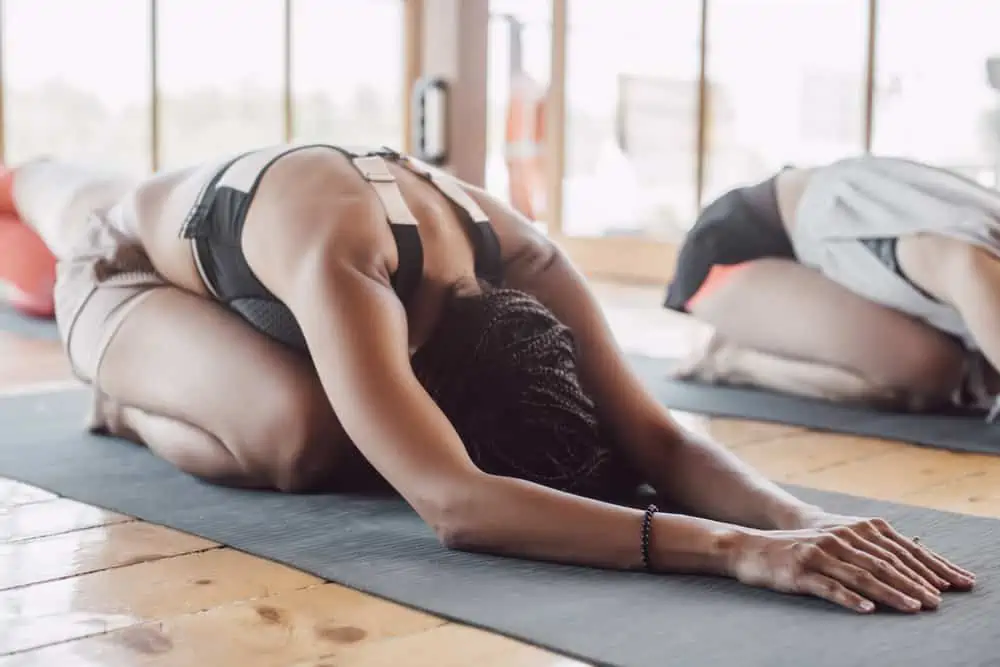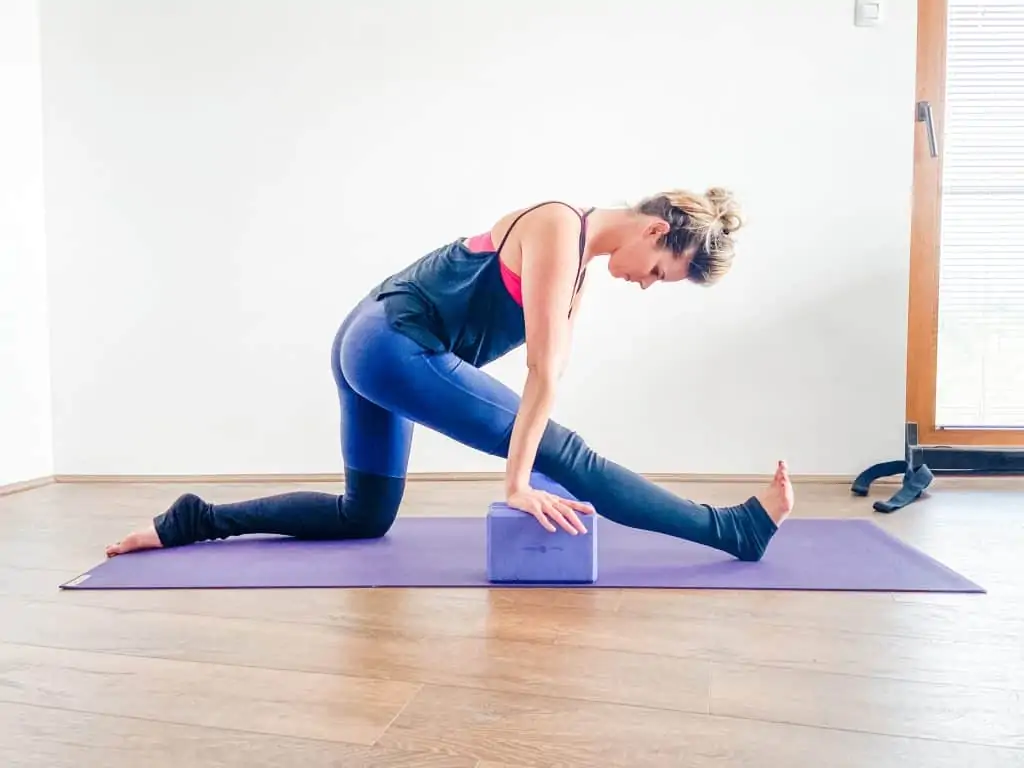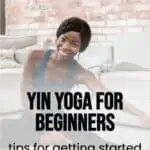This page contains affiliate links. I’m part of the lululemon collective and will receive a commission if you make a purchase through the links below. As an Amazon Associate, I earn from qualifying purchases. Read the full disclosure here.
If you’re new to yoga, you may have noticed many different styles.
Which one should you start with?
While yin yoga is a slow-paced class, it can also be challenging. But don’t click away just yet.
Can beginners do yin yoga? Of course!
This article will help you understand some underlying concepts and outline helpful tips to make sure you keep yourself safe and get the most out of your yin practice.
Let’s get started!
Disclaimer: This content is for educational purposes and is not medical advice. Read the full disclaimer.
What is yin yoga?
Let’s first discuss what yin yoga is and how it differs from other styles of yoga.
The name, yin, comes from the Chinese philosophy of yin and yang.
Yin tissues of the body are plastic (e.g., deep fascia, ligaments, joints), and yang tissues are elastic (e.g., muscles and tendons).
Yin is connected to cold and yang to hot. (More on this in a bit and how it relates to the practice of Yin yoga.)
Yin poses are also connected to energy meridians and the chakras.
In theory, yin yoga targets the plastic tissues.
Since fascial tissue is intertwined throughout the body, it’s obviously not so black and white (for example, only moving the fascia and not the muscles) but when heat gets involved, it does change the elasticity and flow of certain tissues and fluids.
Yin yoga is performed “cold,” meaning without activity beforehand like Vinyasa yoga, Ashtanga yoga, Hatha yoga, power yoga, or other exercises.
The theory is that if you’re warm, more of the motion will pass through the (yang tissues) muscles, and you won’t access the deeper plastic tissues.
Something worth noting, it’s popular to see “vin to yin” yoga classes.
While this is a clever rhyming marketing technique, it goes against the traditional theory of practicing cold and doesn’t carry all of the benefits of yin yoga.
Yin yoga poses are typically held for 2-5 min with some gentle movement transitions in between. Tissues of the body need appropriate stress forces to remain strong and heal from injury. Holding poses for 2-5 minutes stresses these deeper plastic tissues.
Yin is sometimes confused with restorative yoga because of its slow pace. In reality, they are two very different practices. You can read about the differences in this article.
With restorative, the goal is to decrease sensation. Whereas during yin, we want to feel the sensation.
When you release a pose, you’ll likely feel a flood of sensation to the area. This is called the rebound effect.
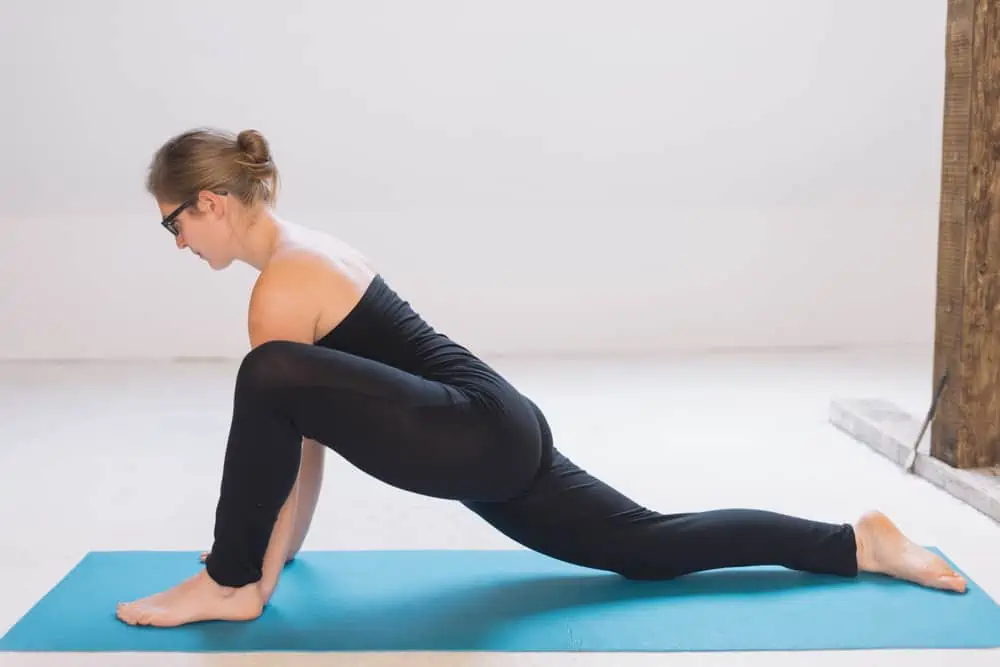
Benefits of yin yoga
Yin yoga carries some benefits of yoga in general, and then some specifics are unique to the yin practice.
- Helps to reduce stress and anxiety to promote mental health by slowing down and focusing on present mindfulness
- Improve flexibility, joint mobility, overall movements
- Helps with balancing the flow of energy, prana, and chi throughout the body
- Helps strengthen the plastic tissues via stress-strain theory
- Helps move your body in new ways that you don’t get from traditional yoga or fitness activities
Many studies have been done on the benefits of yoga, however, there are minimal studies looking specifically at yin yoga.
Daukantaitė D et al. found positive effects on stress and cardiovascular risk factors with a five-week yin yoga-based intervention.
Who should be cautious with yin yoga?
Yin may present a risk during pregnancy due to the increase of the hormone relaxin, increasing ligamentous laxity, and making joints more unstable or prone to injury.
I would also not recommend yin (or use extreme caution) for those with certain types of connective tissue disorders, hypermobility, osteoporosis, osteopenia, and recovering from certain types of injuries.
Poses requiring extended time in lumbar flexion are not recommended for osteoporosis or vertebral disc issues.
Those experiencing lumbar disc herniations or sciatic pain need props to adapt or perform different poses.
Yin also may not be ideal for trauma-informed populations due to the long hold times and intense sensations.
If you have any specific concerns, speak to a qualified yin yoga teacher.
What should I be feeling during yin yoga?
Defining sensation is a significant piece of success with yoga or any physical activity to avoid injury.
In any yoga class, it’s very common to hear the phrase “listen to your body,” but what does that really mean?
Yin poses are typically held for 2-5 minutes for maximum results. This can seem like an eternity sometimes.
Props such as blocks, blankets, and bolsters are recommended to tailor poses to the right level of sensation for you without risking injury.
Yin yoga postures can bring about new and uncomfortable sensations, but not all sensations are bad.
Let’s go through sensations that might be ok to explore and sensations that signal you should back off.
Sensations to explore
Finding your comfortable edge and acknowledging those boundaries can help keep you safe during your yin yoga practice.
- Pressure
- Tension
- Pulling
- Stretching
- A sensation of muscles working
- Releasing tension as you unwind from poses
- Heat
- Sensations of breathing, circulation, or energy flow
Sensations *not* to ignore
These sensations signal a boundary or red flag and should not be pushed into.
- Pain (especially sharp, shooting, intense, or worsening)
- Resistance that feels like a “hard block”
- Muscle cramps
- Tingling
- Numbness
- Dizziness
- Headaches
- Exacerbation of any symptoms that are specific to you
- Difficulty breathing or the feeling that you need to hold your breath to accomplish a movement
*If you cannot continue to connect with your breath, that’s an excellent indicator to back off, use props, or seek a variation.*
Also, since you’re not generating any heat during a yin class, you may feel very cold. So you might want to have leggings, socks, and a sweatshirt or wrap to keep yourself comfortable during your practice.
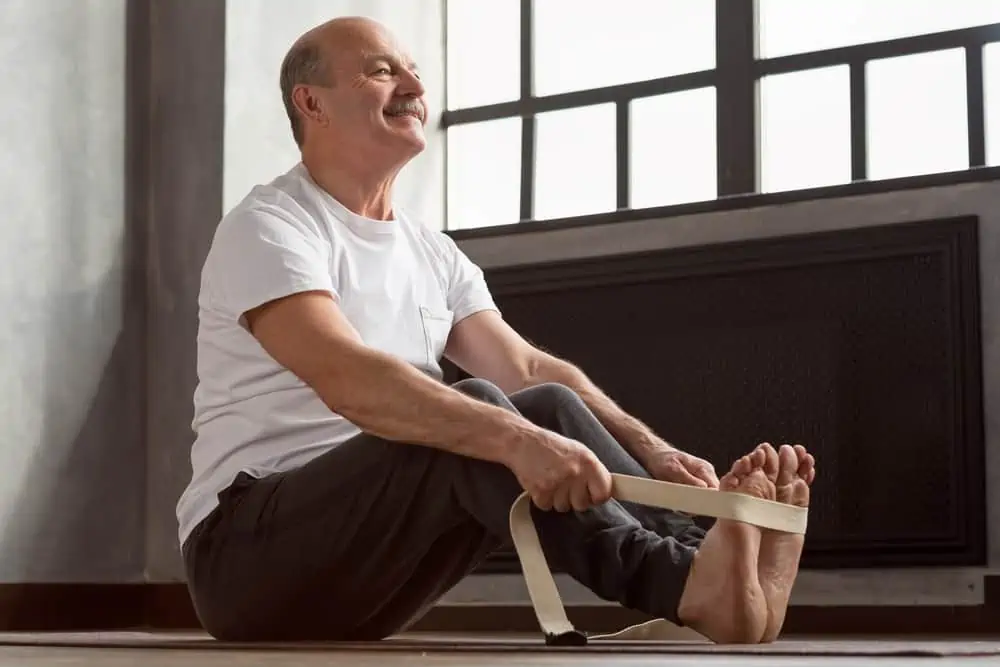
Importance of yoga props in yin yoga
Yin yoga brings you to your edge, whatever that means for you.
Yoga props play a significant role in supporting your posture to allow you to stay at that edge relatively comfortably.
Props are not a sign of “weakness” or that you’re “not good” at yoga. It simply means that everybody is different, and various poses will be more or less comfortable.
Props help you maximize your comfort and your practice.
Beneficial props to have during your yin practice:
Blankets can be folded or rolled for a soft yet supportive surface to take up space. They can also be laid over blocks to add some cushioning and softness.
Blocks are ideal for certain yin poses or any time you need firm support. Blocks come in a variety of materials and sizes.
Bolsters help provide firm but comfortable support to the torso or legs in a variety of positions. Pillows are a good substitute at home but will have more give than the average bolster.
A yoga strap will help extend your reach to maintain good alignment without straining.
A chair is like a super big yoga block and is excellent for supporting the upper body to keep the torso more upright during forward fold type poses. This backless yoga chair can give you the support and space to explore your practice.
Breathing in yin yoga
You might be wondering what you’re supposed to do during those 2-5 minutes for every yin pose.
It can be frustrating to maintain a pose for this long, absorb new sensations, and quiet the mind.
Maintaining your connection to your breath during yin yoga helps bring some calming to the nervous system and tap into the relaxation benefits of the practice.
The autonomic nervous system is part of the peripheral nervous system and regulates involuntary heart rate, respiration, digestion, etc.
There are the sympathetic and parasympathetic nervous systems within the autonomic nervous system.
The sympathetic system is your fight-flight response, funneling energy to the most vital processes at that time. The parasympathetic system covers rest and digest.
Deep breathing activates the parasympathetic nervous system and helps to decrease stress and anxiety to restore balance within the system. Tapping into this relaxation response helps you release and let go into your practice.
Ujjayi breath
Ujjayi breath (Ujjayi pranayama) is a common breathing technique in yoga.
This calming breath helps lengthen the exhalation phase and makes a soothing rolling ocean wave sound, similar to the sound when holding your ear up to a seashell.
Lengthening the exhale helps tap into the relaxation response, activating the parasympathetic nervous system. Therefore, Ujjayi breath is beneficial on or off the mat.
Ujjayi breath can be a little tricky at first, but it’s a wonderful way to bring attention to your breath and relax once you get comfortable with it.
How to perform Ujjayi breath:
- Ujjayi breath can be done seated comfortably or during a yoga practice
- Inhale through the nose
- As you exhale, gently constrict the back of the throat with the mouth closed to make an ocean sound
- Focus on lengthening the exhalation phase
- Repeat as needed
How many days a week should I do yin yoga?
A yin practice can complement other styles of yoga or fitness activities 1-2 times per week.
Where to find yin yoga practices
Yin practices can be found at a yoga studio or sometimes gym with a well-developed mind-body program.
Be sure to try different classes and instructors to get a true taste of yin yoga.
You can also practice yin yoga at home with the resources below. Here are some YouTube channels where you can find free Yin yoga videos.
Yoga Download also has plenty of yin yoga content as well as other styles of yoga for all levels, with access to over 1700 on-demand classes.
They have an easy-to-follow menu with lots of options for beginners. Choose a class by yoga style, length, instructor, focus/goal, and more. In addition, yoga Download offers programs and challenges with different themes to get you in the habit of a regular yoga practice.
There are helpful resources for beginners, including a guide to all different yoga styles, a pose guide (which you don’t need a membership to access), and workshops for technique.
Save 50% off Yoga Download Monthly Online Yoga Packages here.
Helpful books about yin yoga
If you want to learn more about yin yoga, how to support your body during poses, and variation options, check out the books below.
The Complete Guide to Yin Yoga: The Philosophy and Practice of Yin Yoga by Bernie Clark is a fantastic resource for both students and teachers of yin yoga.
This book digs deep into the philosophy of yin, as well as photo demonstrations of common poses, variations, and precautions.
This book is a must-read for anyone interested in yin yoga!

One of my favorite YouTube channels, Yoga with Kassandra, also has a book about yin yoga, with plenty of pose ideas and pictures.
Yin Yoga: Stretch the Mindful Way by Kassandra Reinhardt is another wonderful book for yin practitioners or teachers.

Both of these books come in a physical book and kindle edition.
Though not a book, Tummee is a yoga teacher sequence builder that goes into great detail with each pose.
They have plenty of yin poses to learn about, get inspired, and build your practice sequences. Tummee is an excellent resource for yoga teachers.
Use my referral link for 1 month free when you sign up for an annual plan.
Wrapping Up
Each style of yoga is unique and offers many physical and mental benefits.
Understanding the differences between these styles can help you deepen your practice and enjoy more of what yoga has to offer.
Use these tips to enjoy your next yin yoga class while keeping yourself safe.
Have you tried yin yoga?
References
Benjamin, M., Ralphs, J.R., “Fibrocartilage in tendons and ligaments — an adaption to compressive load.” Journal of Anatomy (1998).
Clark, B., The Complete Guide to Yin Yoga (2012).
Daukantaitė D, Tellhed U, Maddux RE, Svensson T, Melander O. Five-week yin yoga-based interventions decreased plasma adrenomedullin and increased psychological health in stressed adults: A randomized controlled trial. PLoS One. 2018;13(7):e0200518. Published 2018 Jul 18. doi:10.1371/journal.pone.0200518
Frida Hylander, Maria Johansson, Daiva Daukantaitė & Kai Ruggeri (2017) Yin yoga and mindfulness: a five week randomized controlled study evaluating the effects of the YOMI program on stress and worry, Anxiety, Stress & Coping, 30:4, 365-378, DOI: 10.1080/10615806.2017.1301189
Myers, T. Frederick, C., Stretching and Fascia. Fascia: The Tensional Network of the Human Body (2012).
Schleip, R., Muller, D.G., Training principles for fascial connective tissues: Scientific foundation and suggested practical applications. Journal of Bodywork & Movement Therapies (2012).

